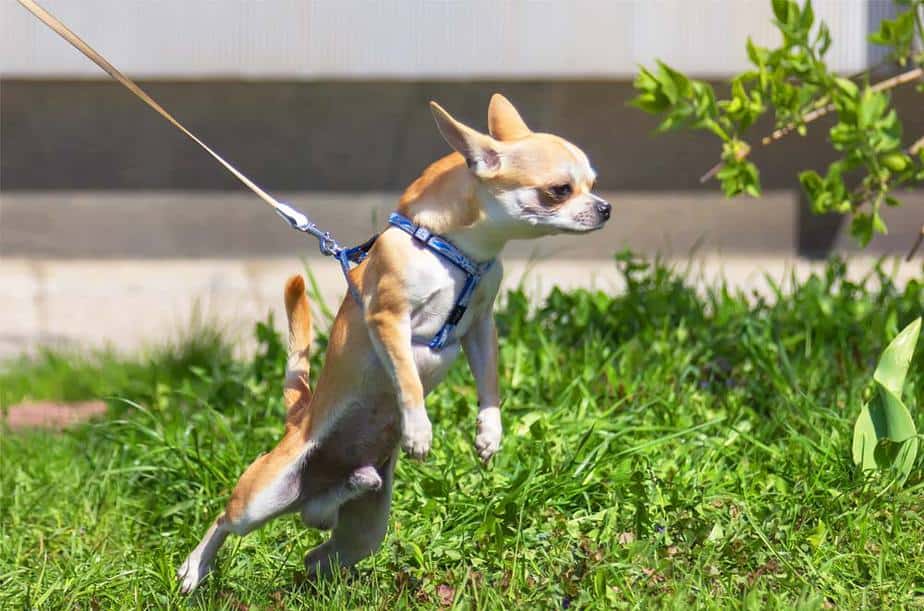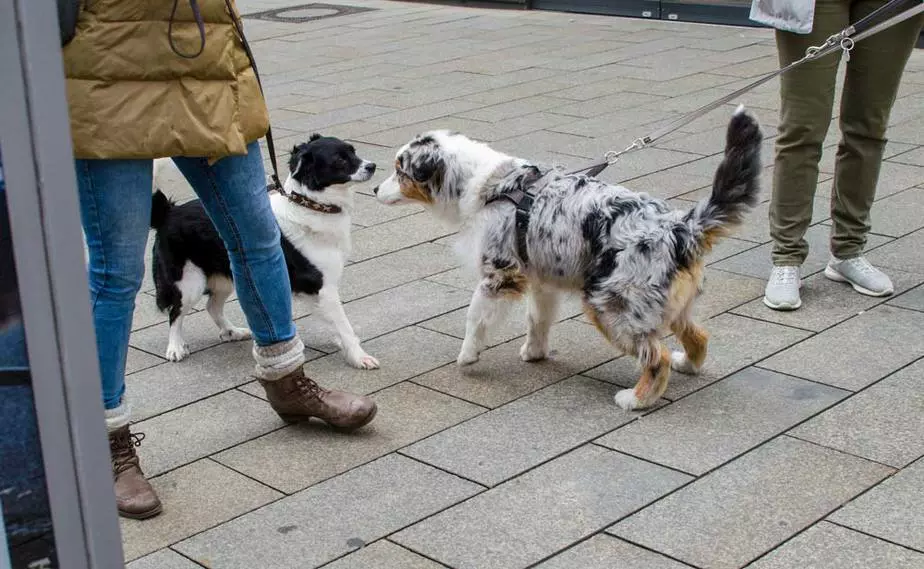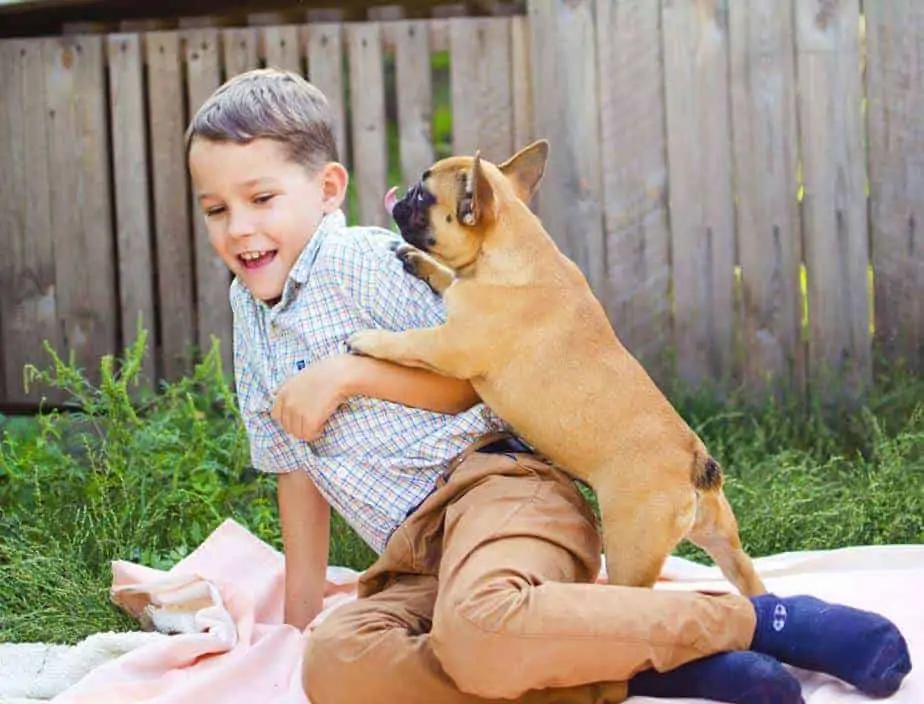If your puppy is lunging, it’s normal to be concerned. Sometimes puppies lunge at faces, and other times puppies lunge at strangers or other dogs. No matter the situation in which your puppy is lunging, there are steps you can take to stop them in the future.
In this article, we will explore reasons why your puppy might be lunging, how to tell if your lunging puppy is aggressive, and how to stop your puppy from lunging…
Is Your Puppy Lunging Aggressively?
The first step in determining how to stop your puppy from lunging is to determine if they are doing so out of excitement, aggression, or frustration. Sometimes, several of these can play a role in one situation.
In general, a puppy that is excited will be loose and wiggly. They may bark, jump, whine, and wag their tail so that their whole body is wiggling.
Sometimes, this also leads to a frustrated puppy. In fact, the lunging itself can often be a behavior that is performed out of frustration for not being able to reach the person they are excited about.
In contrast, a puppy that is lunging due to aggression will often be very stiff and still right before they lunge.
They also might growl, and may still wag their tail, although it’s likely to be a very stiff tail wag rather than one that wiggles their body.

Examining the context in which your puppy is lunging is also important. If they are on leash and lunging at someone who has petted them in the past, they are more likely to be lunging out of excitement and frustration.
However, if your puppy is usually cautious or reserved with strangers, and you pass someone on the sidewalk in the dark, your puppy might be uncomfortable with the situation and lunging to make the scary person go away.
If you see other signs of aggression in your puppy, it’s important to seek professional help immediately. It’s not normal for most puppies to display aggression, so getting a professional dog trainer or behavior consultant on board ASAP will make sure you tackle the problem efficiently and effectively.
If you think your puppy may have a problem with aggression, please read our comprehensive guide to puppy aggression.
Puppy Lunging at Faces
It’s common for puppies to want to lunge at faces, especially if they are young and haven’t been taught otherwise. Puppies want to lick faces and be as close to faces as possible, and sometimes the best way to reach those faces is to throw themselves at them!
If you watch puppies play, you will often see that they playfully bite at each other’s heads. If you don’t teach your puppy proper ways to interact with humans, they are likely to try this same play behavior with people, too.
Sometimes, we accidentally reinforce puppies biting at our faces. When puppies are little, it can even seem cute. That is, until they are big enough to still jump and lunge at our faces when we are standing!
If your puppy is lunging at your face, it’s a sign that they are too overstimulated and excited and need a break to calm down. This means that we need to stifle our often natural reaction of yelling and pushing the puppy away, because that is likely to make the puppy even more excited.
Instead, try to calmly react. If your puppy is small, you can pick them up. Puppies that are overstimulated enough to bite and lunge at faces often are like toddlers who need a nap, so putting your puppy in their kennel or in a safe place by themselves for a break is a great way to deal with lunging at faces.
A pen is also a great place to put an overexcited pup. It’s not a punishment timeout, but a timeout to calm down. If you puppy is overexcited a lot, then you might want to read our post about that here.
Teaching correct play behavior
It’s also important to teach your puppy how to properly play with you. One way to do this, especially with puppies who are teething and want to bite, is to ask your puppy to grab a toy instead.
Some dogs will enjoy holding a toy while playing a game of chase or wrestling, and other dogs will prefer to play a game with the toy itself. Snaking the toy along the ground for your dog to pounce or tossing the toy for a game of fetch are two great ways you can use your puppy’s toys to redirect their behavior.
Teaching your puppy “Place” is also a highly effective method of controlling lunging puppies, as they can often be over-tired and sending them off for a nap can be just what the doctor ordered. You can read more about that here.
In addition to redirecting your puppy with a toy or putting them in a place where they can nap, you can also focus on teaching your puppy what you want them to do instead.
This method is especially helpful if you find your puppy lunging at your face in a specific situation, such as when you are sitting on the ground with them.
Don’t wait for your puppy to lunge at your face before training another behavior. Instead, when you are in a situation where your puppy might lunge at your face, practice having them do something else (like sit) instead.
With practice, your puppy will learn that lunging doesn’t work to get attention, but that sitting gets them treats and attention instead! This is the fundamental step in teaching a puppy the behaviors you want to see in them.

Dog Lunging at Strangers and Other Dogs – Lunging on the Leash
Again, if your dog or puppy is lunging aggressively at strangers, we’d strongly recommend seeking professional help. The International Association of Animal Behavior Consultants and the Certification Council for Professional Dog Trainers are two great places to start your search.
However, if your dog is lunging at strangers out of excitement or frustration, there are several things you can try first.
One of the best ways, as with lunging at faces, is to teach your dog how to do something else instead.
Your dog can’t lunge at strangers and sit at the same time, so if we teach them how to sit around distractions, they won’t be able to lunge!
Steps to curing the Puppy Lunge!
STEP 1: To start, you’ll want to practice having your puppy sit without any distractions around. Practice this until they can sit quickly on your first cue!
TIP: Training is easier to achieve with high value treats. Find the ones your puppy likes best!
STEP 2: Next, try adding in a few small distractions. This might mean training in your backyard instead of inside, or it might be as simple as training in the kitchen when you usually train in the living room.
STEP 3: As you add distractions to your training, you’ll then be able to start adding the distraction of a stranger. If you have a friend or family member willing to play the role of a friendly stranger, that can make your training even easier.
STEP 4: Starting with the stranger at a distance, practice having your puppy sit for treats. You might consider bringing treats that are really delicious, like chicken or hot dogs, instead of the normal treats you are using for training.
STEP 5: As your puppy is successful, shorten the distance! If you are consistent and make sure to practice, your puppy will be sitting when strangers walk by in no time.
Since it might not be possible to fully avoid strangers until you reach this point, it’s also important to have a few ideas of ways you can manage the situation.
This is especially true if you can’t increase the distance enough for your puppy to be successful by moving to the side of the path or walking the other direction.
A contingency plan
One way to manage your puppy when you have to walk by strangers is to turn your hand into a treat magnet. With multiple treats in your hand, put it at your side and get your puppy to stick their nose right up to your hand.
As you walk away or walk past the stranger, slowly uncurl your fingers one at a time, starting with your pinky finger, to let them eat the treats. Your puppy will be so excited about the wonderful treats that they won’t have time to lunge at a stranger.
Another great option for puppies that lunge at strangers out of excitement is to join a local group class. Make sure the class is being taught with positive reinforcement methods!
You might like to learn more about puppy classes in our post, PetSmart VS Petco: Puppy School and Training Comparison
In a group class setting, you’ll be able to practice the skills you’ve been working on at home in an environment with more distractions. You’ll also have a professional dog trainer at your disposal who can help you with solutions.
You might also like to read our post, Why Is My Puppy So Naughty? (Explained)
Final Word
It’s natural for your puppy to be so excited by people that they will lunge. But like all behaviors with puppies, we can teach them what we want to see in their actions. The absolute best way to do this is through positive reinforcement.
If your puppy is lunging, then remember this important point: Distraction is your key to success! Whether it’s treats or toys, find the things your puppy loves and use them to your advantage.
It’s also important that you don’t yell or scold your puppy. They are new to the world and learn with their mouth. Teaching them the correct behavior is always best done with positive reinforcement and distraction.
As you puppy grows, their neural pathways will follow the positive experiences you give them. If you teach your puppy through hard discipline, they will grow into an anxious dog, and one that is far more likely to lunge at a face out of aggression.
And lastly, while getting a dog trainer can seem like an expense you just don’t want, even a short session with a good trainer can be so helpful in teaching you how to control your puppy.
And that little bit of extra help could be all you need to turn your rambunctious pup into a little angel… well, mostly.




